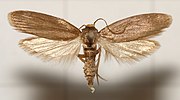Apis laboriosa or Himalayan giant honey bee, is the world's largest honey bee; single adults can measure up to 3.0 cm (1.2 in) in length. Before 1980,...
7 KB (896 words) - 13:46, 7 October 2024
Kush Himalayan range, it is produced by Himalayan giant honey bees (Apis laboriosa). Honey hunting in Nepal has been traditionally performed by the Gurung...
26 KB (2,687 words) - 15:30, 6 January 2025
Honey bee (redirect from Apis (genus))
bee); Apis koschevnikovi (Koschevnikov's honey bee); Apis laboriosa (the Himalayan giant honey bee); Apis mellifera (the western honey bee); and Apis nigrocincta...
100 KB (11,754 words) - 11:51, 27 December 2024
cavities. Other honey bee species, including the giant honey bees Apis dorsata and Apis laboriosa, generally construct nests consisting of a single comb in open...
41 KB (5,109 words) - 02:41, 29 September 2024
western honey bee), Apis cerana, and Apis florea. Apis dorsata belongs to the subgenus Megapis. There are a few hypotheses as to when Apis dorsata diverged...
26 KB (3,332 words) - 11:06, 17 April 2024
years in temperate climates. These mites can infest Apis mellifera, the western honey bee, and Apis cerana, the Asian honey bee. Due to very similar physical...
39 KB (4,483 words) - 19:01, 1 January 2025
honey bee Apis laboriosa Apis mellifera adansonii Apis mellifera artemisia Apis mellifera litorea Apis mellifera pomonella Apis mellifera meda Apis mellifera...
13 KB (1,457 words) - 19:52, 13 September 2024
and Pakistan. Their primary hosts are the larva of Apis dorsata and Apis laboriosa, although after Apis mellifera was imported to Asia, they were found to...
3 KB (290 words) - 00:56, 4 May 2024
larva of Apis dorsata and Apis laboriosa but can also infect Apis mellifera Varroa destructor, bee mite that attacks honey bees Apis cerana and Apis mellifera...
393 bytes (77 words) - 17:57, 14 April 2024
which there are four species, are native to Apis dorsata, Apis laboriosa, and Apis breviligula, but spread to Apis mellifera after they were introduced to...
91 KB (10,196 words) - 14:11, 24 December 2024
highest documented for honeybees, aside from Apis dorsata, Apis laboriosa, and Apis cerana nuluensis, the only Apis species that do not have documented paternity...
15 KB (1,973 words) - 03:23, 11 August 2024
gather around cliffs that are home to the world's largest honeybee, Apis laboriosa. As they have for generations, the men come to harvest the Himalayan...
8 KB (962 words) - 23:00, 1 October 2024
samples revealed 96% were N. ceranae, 3% had both N. ceranae and N. apis, and 1% had N. apis only. When healthy bees are fed pollen filled with fungicides,...
141 KB (15,725 words) - 15:36, 12 December 2024
parasite and scavenger of bee colonies, especially for honeybee colonies, Apis mellifera. The honeybee’s alarm pheromone, especially of European honeybee...
37 KB (4,367 words) - 17:46, 3 August 2024
the surface of the comb. They feed mainly on the foundation wax of Apis laboriosa that attach the comb to rocks. They feed on active beehives without...
8 KB (821 words) - 10:54, 22 July 2024
species Apis florea. Recent studies have highlighted notable differences between the bees and have thus separated them into distinct species. Apis andreniformis...
18 KB (2,266 words) - 20:30, 13 January 2024
Nepal and is 3 mm in length. Both species are found in the nests of Apis laboriosa Megabraula antecessor Grimaldi & Underwood, 1986 Megabraula onerosa...
2 KB (96 words) - 21:46, 20 November 2023
cliff honey bee Apis laboriosa Hymenoptera tr̀háay kɔ̀ɔy dwarf honey bee Apis florea food Hymenoptera tr̀háay sʔɔ́ɔŋ giant honey bee Apis dorsata food Hymenoptera...
34 KB (74 words) - 15:07, 26 June 2024
viruses affecting honey bees. While most commonly infecting the honey bee, Apis mellifera, it has also been documented in other bee species, like Bombus...
17 KB (2,226 words) - 06:00, 17 December 2024
honey bee Apis laboriosa Apis mellifera adansonii Apis mellifera artemisia Apis mellifera litorea Apis mellifera pomonella Apis mellifera meda Apis mellifera...
16 KB (1,794 words) - 11:59, 16 May 2024
in India; Apis dorsata (Rock bee), the Himalayan species, Apis laboriosa), Apis cerana indica (Indian hive bee), Apis florea (dwarf bee), Apis mellifera...
11 KB (1,111 words) - 07:59, 2 October 2023
New Guinea from western honey bee hives. Hosts are primarily Apis dorsata, A. laboriosa and A. breviligula. Includes A. cerana. Delfinado-Baker, M.; Aggarwal...
3 KB (267 words) - 11:54, 16 May 2024
making use of the attacks of Vespa mandarinia on the hives of Apis dorsata laboriosa. He also saw a honeyguide in the Valley of Flowers which he suggested...
15 KB (1,560 words) - 12:08, 13 October 2024


















